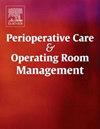Association between pre-anesthetic subclavian vein collapsibility index and post induction hypotension in patients undergoing elective surgical procedures; An observational study
IF 1
Q2 Nursing
Perioperative Care and Operating Room Management
Pub Date : 2025-06-26
DOI:10.1016/j.pcorm.2025.100512
引用次数: 0
Abstract
Study objective
To study associations between the pre-anesthetic subclavian vein collapsibility index (SCV-CI) during tidal and deep breathing and post induction hypotension (PIH).
Design
Observational cross-sectional study.
Intervention
Pre induction SCV USG.
Measurements
Minimum and maximum diameters of the SCV during tidal and deep breathing were measured and SCV-CI was calculated. Post induction hypotension (PIH) was defined as a fall in MAP>30 % of baseline or MAP <65 mmHg.
Results
Data of 74 patients was analyzed. After induction of GA, 31 patients (41.9 %) developed PIH. The baseline MAP and SCV-CI (deep) were higher in patients who developed PIH as compared to those who did not (p < 0.01, p = 0.03 respectively). The unadjusted odds ratios for predicting PIH suggested that baseline MAP, SCV-CI (deep), and maximum SCV diameter (deep) were significantly higher in patients who developed PIH (p = 0.01, p = 0.03 and p = 0.04)respectively. However, after multivariate logistic regression analysis, only the baseline MAP and SCV-CI (deep) remained significant independent predictors of PIH (p = 0.02 each). An ROC curve using the SCV-CI (deep) for prediction of PIH revealed an AUC of 0.64 (95 % CI: 0.51–0.77). The best cut off using Youden index was 29.44. There was a 61.29 % sensitivity, 67.44 % specificity, a 57.58 % positive predictive value and a 70.73 % negative predictive value.
Conclusion
The baseline MAP and SCV -CI (deep) were identified as significant predictors of PIH. However, ROC curve analysis demonstrated that SCV-CI (deep) had only limited diagnostic accuracy, indicating its poor clinical utility as a standalone predictor of PIH.
选择性手术患者麻醉前锁骨下静脉塌陷指数与诱导后低血压的关系观察性研究
研究目的探讨麻醉前潮汐和深呼吸时锁骨下静脉塌陷指数(SCV-CI)与诱导后低血压(PIH)的关系。设计:观察性横断面研究。干预预诱导SCV USG。测量潮汐呼吸和深呼吸时SCV的最小和最大直径,计算SCV- ci。诱导后低血压(PIH)被定义为MAP降至基线的30%或MAP降至65mmhg。结果对74例患者的资料进行分析。GA诱导后,31例(41.9%)发生PIH。与未发生PIH的患者相比,发生PIH的患者的基线MAP和SCV-CI(深)更高(p <;0.01, p = 0.03)。预测PIH的未经调整的优势比表明,发生PIH的患者的基线MAP、SCV- ci(深)和最大SCV直径(深)显著更高(p = 0.01, p = 0.03和p = 0.04)。然而,经过多因素logistic回归分析,只有基线MAP和SCV-CI (deep)仍然是PIH的显著独立预测因子(p = 0.02)。使用SCV-CI (deep)预测PIH的ROC曲线显示AUC为0.64 (95% CI: 0.51-0.77)。使用约登指数的最佳临界值为29.44。敏感性61.29%,特异性67.44%,阳性预测值57.58%,阴性预测值70.73%。结论基线MAP和SCV -CI(深)是PIH的重要预测因子。然而,ROC曲线分析表明,SCV-CI(深)的诊断准确性有限,表明其作为PIH独立预测因子的临床实用性较差。
本文章由计算机程序翻译,如有差异,请以英文原文为准。
求助全文
约1分钟内获得全文
求助全文
来源期刊

Perioperative Care and Operating Room Management
Nursing-Medical and Surgical Nursing
CiteScore
1.30
自引率
0.00%
发文量
52
审稿时长
56 days
期刊介绍:
The objective of this new online journal is to serve as a multidisciplinary, peer-reviewed source of information related to the administrative, economic, operational, safety, and quality aspects of the ambulatory and in-patient operating room and interventional procedural processes. The journal will provide high-quality information and research findings on operational and system-based approaches to ensure safe, coordinated, and high-value periprocedural care. With the current focus on value in health care it is essential that there is a venue for researchers to publish articles on quality improvement process initiatives, process flow modeling, information management, efficient design, cost improvement, use of novel technologies, and management.
 求助内容:
求助内容: 应助结果提醒方式:
应助结果提醒方式:


